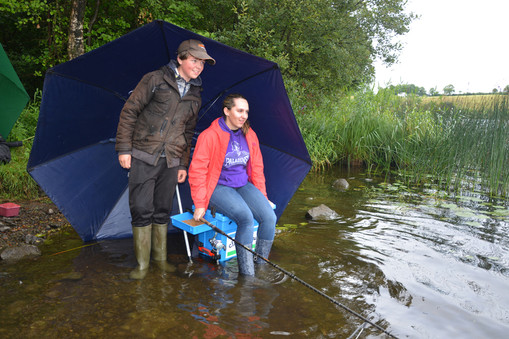Tackling Tench! Fishing With Paddy Murphy in County Cavan during Visit to Ancestral Land
- By Ken Perrotte
- Oct 31, 2017
- 4 min read
Updated: Jul 28, 2022

Note: this article first ran in the Fredericksburg Free Lance-Star in August 2016, right after my return from a 10-day trip to Ireland. Part of the trip was to research ancestors from Counrty Cavan. One goal was to work in a fishing expedition. My delightful Irish hosts made it happen!
KILLESHANDRA, Ireland—When Sean O'Reilly, our host at Eonish Lodge on the shore of beautiful Lough (Lake) Oughter told me he had successfully lined up someone to introduce me to Irish fishing, he caveated: “He’s no guide, mind you, but he’s a regular fisherman and knows the fishing around here.”
“That’s even better,” I said.
Sean’s wife Geraldine said, “Paddy Murphy is his name,” adding with a smile, “That’s as Irish as you can get!”
“No license needed for coarse fishing here; only for sport fishing,” Sean said.
Better yet, I thought.

So, when Patrick “Paddy” Murphy showed up after breakfast on a rainy Irish morning, telling me he had chest waders and wading boots for me to wear and that he’d already prepositioned seats and umbrellas at a nearby small lake, I began thinking it was all too good to be true.
My Ireland visit was one I had hoped to make for years, ever since learning my Irish third great-grandparents on my mother’s side had emigrated to America in the late 1840s during the horrible famine. My grandmother, Mary Farley (then Farrelly), hailed from County Cavan and the countryside just a couple of kilometers from the town of Virginia.
County Cavan, off the beaten tourist path and just a few kilometers from Northern Ireland, is known for superb fishing and is popular with many Europeans on fishing “holidays.” It has so many lakes, big and small, plus two rivers, that you could fish a different body of water every day.
In Ireland, you can opt for “sport” fishing for species such as trout and salmon or “coarse” fishing for lake and pond fish such as bream, tench, roach, perch, a variety of hybrids and more. These same ponds and lakes also contain big northern pike.
New Fish & Techniques
Irish bream aren’t at all similar to what we Yanks would call a bream, usually a bluegill. These European bream are chunky brutes that can top 12 pounds, Murphy said.
While catching bream would be nice, my heart was set on catching a tench. Both tench and bream belong to the fish family Cyprinidae, which includes carp. They have bronze-green body color and small scales. Bream appear to be a little stockier with a hump rising to the dorsal fin. The more streamlined tench have reddish-orange eyes and a mouth with lips somewhat reminiscent of carp. Once known as the “doctor fish,” tench slime was sometimes applied to human wounds.
You can eat them, but Murphy said all his fishing is catch and release.
“The Irish fish from the bank,” Sean said, although Murphy added that pike fishing often takes place from a boat.
Now, whenever I’ve gone bank fishing it’s usually a very low-tech affair, with a cheap rod and reel, and maybe a bobber. Nightcrawlers and crickets are old standby baits.
Murphy, a young 71 years, also started modestly. “When I first started fishing, I’d cut a straight piece of pole out of a hedge, attach a bit of line and a big hook, get a few worms and I was in business. My float was the cork out of a Guinness bottle,” he said.

Today’s coarse fishing can be elaborate, akin to the more technical surf fishing operations I’ve observed. Expensive rods, some 70 feet in length and costing thousands, are available. Smartly-engineered carts that transform into chairs with built-in tackle boxes can cost several hundred euros, Murphy said.
Our set-up was a little more basic. Murphy had 12-foot “feeder” rods with quiver tips that showed when you were getting a bite. Our “ordinary” spinning reels were spooled with 8-pound line finished with an 18-inch, 6-pound leader. A smallish, size 12, semi-barbless hook was at the terminus. “It’s just a wee barb,” he said, adding it makes releasing the fish easier.
A swim feeder was attached to the line just above the leader. This is a tiny, open-ended cylinder used to carry food that attracts fish. A fine bread crumb mixture is mixed with a host of additional ingredients, including live maggots, sweet corn, small worms and even molasses. Maggots or worms often are the bait on the hook. Some maggots are dyed red, which is said to induce more bites. Bronze and white colorations are also available.
He also owns some float rods, which are slightly longer. These are used with slip bobbers.
Tench Triumph
Murphy pitched his bait into a hole about 8-10 feet deep in a corner of the lake, just past some lily pads. Waving his arm toward the middle of the small lake, he said, “I caught a few nice tench here a couple weeks ago, but I don’t like our chances today.”
Little breeze was blowing. Rain fell steadily.
“A cloudy, early morning or late evening until dusk with a nice breeze creating a surface chop is when the fish bite best,” he said.
Still, we tried. I caught some extremely small roach and ring perch. By late morning, broken blue began appearing in the sky. The rain subsided and the wind picked up. As if on cue, Murphy’s rod was yanked off its rest by a powerful bite. Minutes later, he was unhooking a 4-pound tench.

Shortly after, I set the hook. Tench have impressive fighting strength. As I held the fish before releasing it, I could see why this “coarse” fishing is so popular in Ireland and England.
While visiting Ireland may not be in everyone’s future, anglers making the trip may want to throw a packable rod and reel in the luggage. Murphy advises visitors to talk to somebody local for advice. “Talk to the people at the B&B where you’re staying. Always try to get a local fisherman who knows the water,” he said.
For more about County Cavan fishing, see www.thisiscavan.ie/fun/go/fishing. For Eonish Lodge, see www.eonishlodge.com.
A modified version of this article appeared in the Fredericksburg Free Lance-Star. See www.fredericksburg.com/sports/outdoors/ken-perrotte-luck-of-the-irish-needed-to-tangle-with/article_62ae48cb-1f2d-5de3-8612-2a96e7b7c708.html.


































Comments